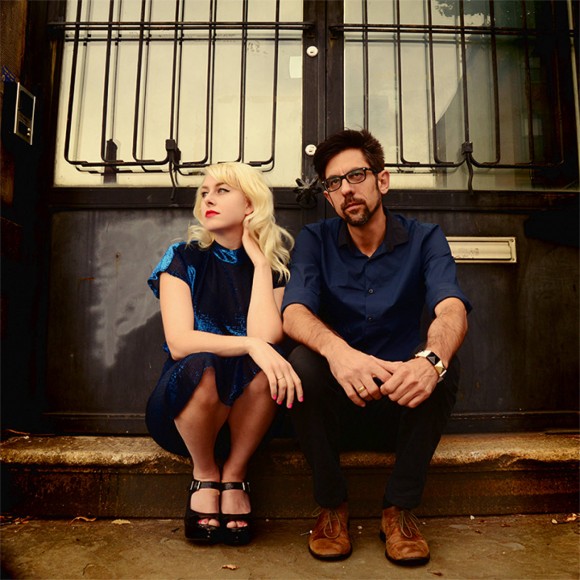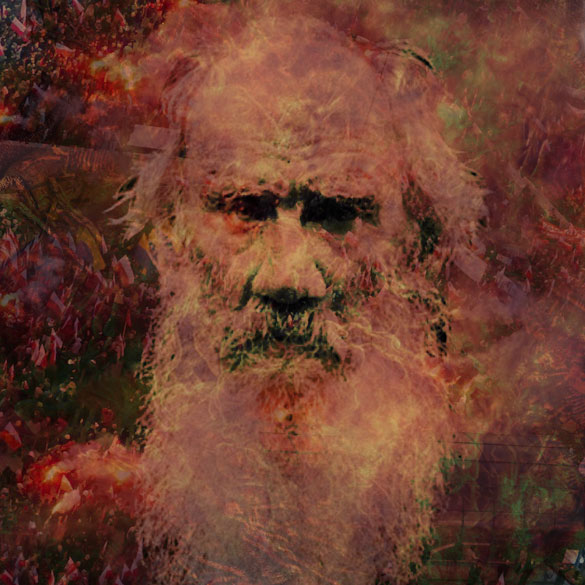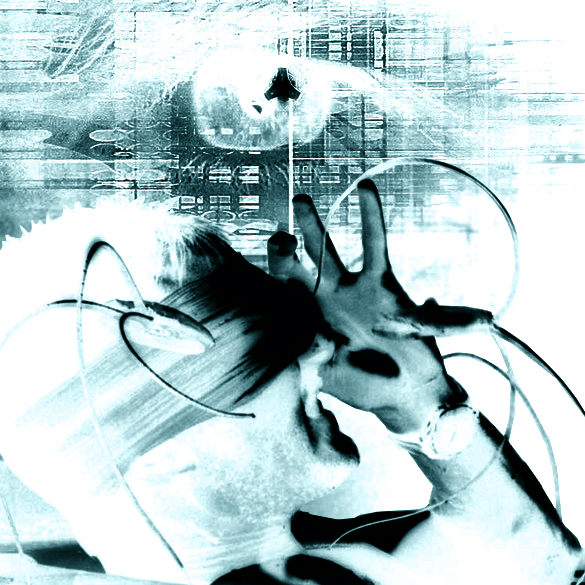Gadfly recently sat down with Evan Sult, drummer for art-pop-rock duo Sleepy Kitty, to discuss the band’s latest album, Projection Room, which can be heard on Spotify. Sult, formerly a member of punky, alt-rock group Harvey Danger, brings unimaginable depth to the pair’s lives, music, and pasts with his insights on their music and future; both he and partner Paige Brubeck are truly remarkable, one-of-a-kind musicians, as is their latest LP, Projection Room, with it’s delightful mixture of edgy femininity and uplifting pop rhythms.
Gadfly ONLINE: Can you give us a brief history of Sleepy Kitty? What parts of your Harvey Danger style followed you through the transition between acts?
Evan Sult: Sleepy Kitty started when Paige and I lived in Chicago together. She was playing guitar and singing in a band called Stiletto Attack, and I was drumming in a band called Bound Stems…Paige and I were both running into static with our bands, so we’d blow off steam just playing music and making art together. It was straight-up fun experimentation, and pretty soon it was the most interesting thing to both of us, and when we found a space in St. Louis that we could turn into an art castle, we did. Moving to St. Louis together made Sleepy Kitty, both band and art-makers, official. Since then, we’ve been releasing albums on STL-based Euclid Records and touring around to support them. And making rock posters and weird visual art stuff and running a music magazine when we’re home.
[…] Harvey Danger was my first band, so I was an enthusiastic learn-by-doing drummer, and I feel like that’s really apparent in the first [Sleepy Kitty] album…Especially in a two-piece, the drums are responsible for taking the reins sometimes, or anyway helping the story get told as vividly as possible. I feel like that’s the thing I’ve been doing with drums ever since: looking for the way to not just play drums but help color the film stock of the movie in your ears, and throw some narrative complications.
GO: I simply adore your music; what artists would you say have influenced your fusion of punk rock and piano pop?
ES: It’s interesting you refer to it as “piano pop,” because the piano is Paige’s most recent writing instrument, and we really don’t employ the instrument very often. That said, I see what you mean — and I think we think of that same element as musical theater. Paige fell just as hard for the Velvet Underground as she did for George Gershwin or Judy Garland or Francoise Hardy, and all of that music gets tangled up in her head in a way that is pretty interesting…in her case I think she feels the chords and emotional complexity and storylines inside those giant pieces of music, but gets a similar jolt from the drone kick of “White Light/White Heat” or “Rhapsody in Blue.” For myself, I love that our band is comfortable weaving passages from other people’s songs — a signature lead line in Hendrix’s “Third Stone from the Sun,” a phrase borrowed from Gene Pitney’s “Last Exit to Brooklyn” — into our own songs, and create new meanings. It’s one of the ways to speak the musical vernacular. The electricity in rock keeps jolting new life into the melodies, ours or anyone else’s, and it’s a joy to hotwire songs and lyrics and chords for our own uses.
GO: Your recently released video for Projection Room single “Don’t You Start” is beautiful, and I think it speaks to the edgy atmosphere of your music! Can you tell us a little about the direction of the music video and why you chose to take it this way?
ES: Sleepy Kitty is really two entities with the same name and the same staff: Sleepy Kitty the band and Sleepy Kitty Arts, all issuing from one big old building on Cherokee Street in St. Louis. Sleepy Kitty Arts makes rock posters and other screenprinted stuff — it’s one of our day jobs…So eventually Paige decided that a screenprinted animation would be a natural way to show how the sounds of the music look to us. It’s a crazy amount of work — at one point we calculated the animations were taking us about one hour of labor per second of finished product — but it does get across a visual representation of our music. I’m glad we included some footage of us printing in our studio to show what we were doing there, all the ink and paper and hand printing and stuff.
GO: More than anything, the Projection Room LP sounds free-wheeling and fun; you both seem to be having fun and letting your hair down! Can you tell us a little about the writing and production process? Where are you taking the album and your career from here?
ES: I’m glad that sense comes across. The album was a kind of gradual accumulation…We wrote four songs pretty quickly after coming home from the tours for [debut album Infinity City], so we went to the tiny rooms of Sawhorse Studios in St. Louis to see what we could do. It was really fun, and funny, to make a bunch of swamp sounds in this really nice studio, or to sing emotively about being ten years old waiting in line for Batman: The Ride at Six Flags…at one point I just started chanting “the rocks that sing the songs of the city!” about one little detail of the ride. Meanwhile, though, there’s a song about one of the most emotionally awkward moments we’ve ever heard on the radio, and some quite emotionally emphatic sections. “Nothing = You” was Paige’s response to listening to a bunch of ’60s French pop. “Godard Protagonist Inflection” was very challenging to make, because it was in Paige’s head before she could figure out a way to show it to me so that I could write to it, which was a first for us. When we finally did work out how to piece it together in the studio, it was exhilarating to hear her blast that guitar solo — it’s so theatrical, this gushing fount of released frustration that has been building up within the lyrics (and of course it doesn’t hurt to picture Brigitte Bardot at any point in that song). Also, we realized at some point that we’d be missing something crucial if we didn’t record some of the album in a dirty noisy basement, so we went to Smoking Baby Studio in town to work with Jason Hutto, one of our favorite producers ever, and got the kind of grotty sounds that satisfy that side of our music too. Tempering the beautiful studio with the gnarly one helped keep it fun and real and relevant to us.
We have taken the album all over the Midwest and West Coast; it’s been a busy summer. We’re still pushing Projection Room this fall and winter…because we’re very happy with how it came out and what it does as a whole. At the same time there’s been a lot of new music happening in the practice space. We’re always kind of at a crossroads with this band: do we do everything ourselves? Do we start involving other musicians, and, if so, in what part of the process?…It’s always tempting to just go ahead and find some other people we like to play with us, and we sometimes do have friends join us for a few songs onstage… but there’s something about the radical limitations of a two-piece, and especially two people who dig each other a lot, that is hard to let go of. And in a lot of ways, it feels like we’ve only just started really working out what we can do…there are plenty of new directions for us to push into. About the only thing we don’t have any interest in is a bunch of pre-recorded tracks backing us. As long as we keep writing and recording and touring nationally, and then internationally, I’ll feel like our career’s on track.
GO: Finally, what does music mean to you? What are you hoping to communicate to listeners with your music and message?
ES: When I was in Harvey Danger and we all lived together and hung out together, we used to spend hours and hours talking about what music was and how it worked and the bands we loved and what we thought they were doing…Now, a lot of years later, Paige and I still spend hours talking about what music is and what it means… and thus I don’t have a quick answer. I do feel like one thing though, is: making music is the best way to find out what it means to make music. And making music over a long period of time is a great way to learn new things about the work that you did before…Music is great in that it’s both momentary — music exists as you’re playing it — and theoretically timeless: the recording stays the same once it’s laid down. And then it becomes a way for you to see how you change or stay the same. I’ve definitely come to appreciate musicians who set out to learn the language of music and its structural underpinnings in an intentional, scholarly way, though that’s not how I ended up making music.
The thing is: I’m the drummer. I don’t write the chords or the lyrics. I’m not saying drums aren’t crucial to the music in the end, but that’s different than music in the beginning, at least most of the time. I don’t write the songs, I co-write the songs; I help bring them into full being by paying attention, and by trying to lead in various directions, by playing with or against the feeling of the guitar or melody. Music from my seat is a way of working together. Sometimes I’m a translator, sometimes I’m a disruptor or an amplifier or a door or the train you’re riding in or the rising storm or just the backbeat.
Music is a form of magic; that sounds absurd, but I bet every musician knows it’s true. It’s the original magic: it’s a spell woven right in front of you. It’s a relationship between you and a secret language of chords and modes and precedent, but it’s also an immediate feeling of discovery and insight. The best feeling in the world is being a part of a group…playing together becomes writing a song together…Creating a song, and invoking it once it’s been written, those are some of the most potent creative feelings in the world…Rock music is fundamentally exciting, a way to speak that has no analog. We get to talk about the things that are rolling around in our heads — frustrations, desires, moments, people — and watch those specific personal thoughts, translated into song, become something that other people can relate to their own lives. That’s amazing. It’s funny, because viewed from a step back, there are a zillion people making rock music, and it’s easy to feel like it’s all been done before… but then we find ourselves in the middle of writing a new song, and that elation kicks in like it did when Harvey Danger wrote “Love Bug,” or when Bound Stems first wrote “Triggered,” and I know that, at least for me, making songs is the message, and that every time I help write a new song that I’m excited about, I’m doing my real job as a human.
It seems that Sult and Brubeck were destined for these musical lives, and fans are overjoyed for this fact. Fans old and new can check out Sleepy Kitty’s first video from Projection Room, “Don’t You Start,” and snuggle into this latest LP like a cozy, warm, simply fun blanket.
—
Candace Carter swims through a sea of schoolwork and work-work on the daily to be able to talk to cool bands and listen to nice music. She loves to write and play with her cat. Check out more of her work at cavalierdaily.com.



